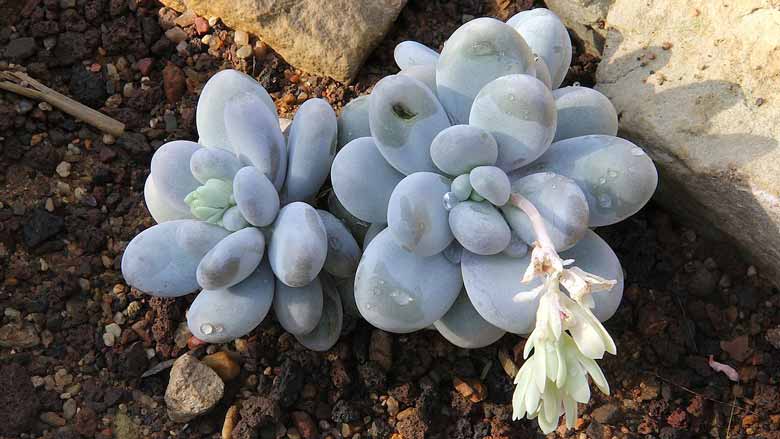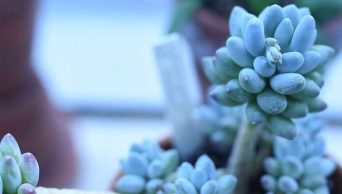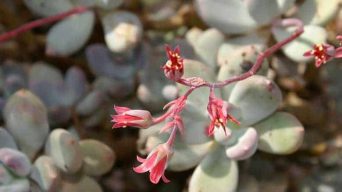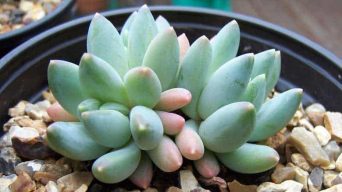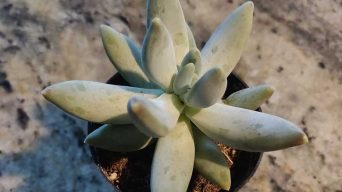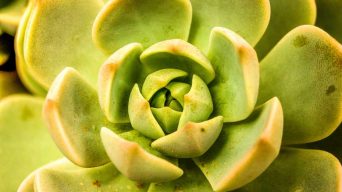The Pachyphytum Oviferum, the Moonstone succulent, is a plant that many people love because of its unique appearance.
It’s also very easy to propagate, making it an excellent choice for gardeners who want the joy and satisfaction of growing their own plants from cuttings.
In this guide, you will learn everything you need to know about Moonstone succulent care and propagation.
About the Moonstone Succulent (Pachyphytum Oviferum)
The Moonstone succulent plant (Pachyphytum oviferum) is a beautiful and rare desert-dwelling succulent that can grow quite large.
This species of flowering succulents, also known as Sugar Almond Plant, Pachyphytums or Moonstones, originates from Mexico, where its natural habitat is the arid climate of Chihuahua in northern Mexico.
The name “Moonstone” refers to how this specific form of Pachyphytum’s spherical leaves resembles those of some kinds of moonstone gems found worldwide.
The most popular use for these plants has been ornamental decoration in gardens and homes.
Moonstone succulents are known for their distinctive appearance and interesting textures when light sources such as lamps or natural sunlight touch them.
Their color is a deep silver-blue with hints of purple caused by the light reflecting off their plump leaves.
There are some Pachyphytum succulent varieties that are known for their color, such as the “Pink Moonstone” and the “Red Beauty.”
The Moonstone succulent plant is a very slow-growing and long-lived type of Pachyphytum, with some specimens over 400 years old!
They grow in the wild at altitudes above 7000 feet (2100 meters). They can live for many decades without needing any care or irrigation whatsoever.
Although these plants are often used purely as ornamental decoration when grown indoors, they still need similar conditions to those found outside their natural habitat.
How To Care for Moonstone Succulent (Pachyphytum Oviferum)
The Moonstone Succulent, also known as the Pachyphytum Oviferum (Pachypse ovifere) plant, is one of the most beautiful succulents.
It’s hard to believe that this unique and rare plant can be so easy to take care of!
Sun Exposure & Light Requirements
The Pachyphytum Oviferum, the Moonstone succulent, has an almost white, silver color.
It thrives in high light conditions and partial shade. It will turn greenish or yellowish with long leaves in low light conditions, but the white spots on the plant remain visible.
To get the best results from growing this succulent, as well as other Moonstones, their needs should be considered when deciding where to place them indoors:
- Place your plants close to windows so they can receive bright indirect sunlight without direct sun exposure.
- If you have a room with high ceilings, a west-facing window provides the perfect light for your Moonstones.
If there is no suitable space near windows and sufficient natural sunlight, fluorescent lights should be used to provide indirect bright light to the plants.
Keep in mind that when using artificial light indoors, it’s best not to place the plant too close so it doesn’t get heat scorch marks from both sun and bulbs. This will also help regulate humidity levels as well.
When planting the Moonstone succulent outdoors, make sure to plant it in an area that doesn’t receive too much direct sunlight.
It is important to note that Moonstones are sensitive plants. They can get sunburned and dry out when exposed to too much light, so be sure not to place them in direct sunlight or under grow lights.
Provide bright indirect lighting or place them indoors near a west-facing window for best results. A west-facing window offers the perfect light for your Moonstones.
Watering Requirements
The Pachyphytum Oviferum (Moonstone Succulent) thrives in a dry environment but also needs water.
Allow the soil to completely dry out before watering again, and only water when the top inch of soil feels like it’s been baked by summer heat. The plant should be watered once a week or every few weeks.
An excellent way to keep the soil dry is by using rocks on top of it. The porousness of these rocks will help provide better drainage, which prevents standing water from building up. This also helps prevent root rot and promotes healthy growth!
You should never water Moonstones from above because the wet soil will stay moist longer than if watered daily.
Watering them from below is the best way to do this- pour some water into your pot and allow it to absorb.
Soil Requirements
Pachyphytum Oviferum thrives when planted in a well-draining potting mix.
If you cultivate it in a container, it’s important to be aware that the soil may become compacted due to regular watering over time.
To address this, I suggest using a mix of 50% regular potting soil and 50% coarse sand or grit to enhance drainage. This is preferable to using a pure cactus or succulent soil mix.
This type of mixture holds moisture better. It also has more nutrients, which are good for Pachyphytum Oviferum’s succulent leaves.
The cactus soil mix should have a pH around neutral with no added fertilizers. If the Pachyphytum Oviferum is in a pot or container, add about an inch of gravel to the bottom to drain any excess water more quickly.
If you’re planting it in your garden, ensure there are at least eight inches between the plant and where rainfall will pool during rain events.
This will help keep moisture levels up while avoiding rot from standing water when things dry again.
Temperature and Humidity Requirements
The Pachyphytum Oviferum is not too difficult to care for.
They can be grown in many different types of environments, including sunny windowsills and shady outdoor gardens.
The succulents are moderately cold tolerant but will need protection from frost when the temperature drops below 50 degrees Fahrenheit (or -45 °C).
For optimal growth, keeping them between 68-86°F (20-30°C) with a humidity level under 60% but above 20% is best.
What Should I Do if My Moonstone Succulent Is Outside?
If you live in an area with a climate that does not get below 50°F (or -45°C) during the winter, it’s best to leave your Pachyphytum Oviferum outdoors.
If the Moonstone succulent has grown well and then freezes or becomes damaged due to frostbite, don’t worry!
All you need to do is cover them up by wrapping old towels around their base so they are entirely insulated from any cold air.
The plants will survive underneath the makeshift blanket as long as there isn’t snow on top of them for too long.
You can remove the covering when warmer temperatures return, but keep the Moonstone plant out of direct sunlight.
What Should I Do if My Moonstone Succulent Is in an Enclosed Space?
If you live in a place where it doesn’t get below 50°F (or -45°C) during winter, your Pachyphytum Oviferum will need to be protected from cold drafts and extreme temperature changes.
Place them near a heat source such as a radiator or fireplace so they can receive some warmth without getting too dry or humid.
You may also find that wrapping old towels around their base will adequately protect them while still allowing air circulation. This helps prevent rot on the plant’s roots.
Fertilizing
Pachyphytum Oviferum plants are not heavy feeders and can do well with just a monthly feeding.
However, if you want your Pachyphytum to grow faster or be more robust in the face of pests, it may need fertilizing every three weeks instead of once a month.
Those who keep their plants inside should water them using liquid fertilizer diluted by half for best results (diluting the mixture helps prevent burning).
Those who grow their succulents outside all year but not with compost or manure will need to fertilize it every week in the summer. The amount required varies depending on the plant’s age, size, and the types of fertilizer used.
For the first week, fertilize with a half-strength solution of liquid fertilizer diluted by 50%.
For the second and third weeks, use a one-quarter dosage. In late summer or fall, when growth slows down to just a few inches for some plants per year, stop feeding it.
Some succulents are sensitive to overfeeding, which can make them appear brown. If this change is not desired, reduce feedings until they return to green before increasing.
Potting and Repotting
The Moonstone succulent can be potted in any container. But for best results, you should use a pot with drainage holes at the bottom and sides for water to leak out.
The sides of the pot need to slope away from the middle so that water can flow out.
Pots with plenty of room for root growth will help your plant grow into more beautiful specimens over time!
When potting or repotting, make sure to remove all dead roots and trim back live ones if necessary.
It’s important not to overwater when doing this process because they have brittle roots sensitive to soil moisture levels.
The best time to repot your Pachyphytum Oviferum is in the early spring or fall when soil temperature and plants are cooler.
Remember to not move a plant from one pot into another while it has flowers on it. This will stress the plant and cause drooping, and loss of flowers, leaves, stems, etc.
Pruning
Moonstone succulents don’t need pruning, but you can trim them if they get overgrown or too top-heavy.
When you’re ready to prune, there are some things you may want to consider before you start:
- Trim your Moonstone’s stems near the base where it meets the soil to control its growth and prevent it from becoming completely rootbound in one area of potting soil.
- Use a sharp pair of clean and dry scissors – any dirt on the blades will cause ragged cuts, which may lead to rotting later on.
- Make sure not to cut off more than 25% at once! You’ll want plenty left for new branches so that future flowers bloom beautifully.
Pests and Diseases
Pachyphytum Oviferum plants are not prone to many pests or diseases. However, that doesn’t mean they couldn’t happen!
Some diseases that can affect the Pachyphytum Oviferum (Moonstone Succulent) plant are:
- Botrytis cinerea: Reddish-brown rot spots on the leaves usually appear during cool, damp weather. This fungus typically grows in wet climates with cooler temperatures along with low sunlight levels.
- Anthracnose: Infected leaves show dark tan spots with a purple center. Leaves can also be distorted or yellowish and exhibit brown spots along the veins of leaves, petioles (stems), and stems.
- Root rot: Roots will appear blackened.
- Leaf spot: Leaves show dark necrotic lesions that are often circular shaped.
- Fusarium wilt: This problem is indicated by wilting on one side of the plant while healthy growth continues on the other side.
Pachyphytum Oviferum Plant can be susceptible to pests. These problems should be treated as soon as possible to prevent any further damage to the plant.
Some pests that can attack your plant include the following:
- Mealybugs: Appear as cottony masses on the stems, leaves, and roots of succulent plants.
- Spider mites: Can be detected by small webs in between branches of the Pachyphytum Oviferum Plant or a white residue left behind after their bites on your plant are taken.
- Aphids will appear as bumps under-ripe yellow leaves while they suck the sap out from underneath. They can also pierce through thin parts of the Pachyphytum Oviferums Plant, which will make it wilt easily.
- Leaf miners: These pests burrow into tender new growth and feed on these areas disrupting proper development and weakening your Moonstone succulent over time.
A diet of soap and water in a spray bottle is the best way to deal with mealybugs, aphids, and spider mites. Use neem oil for leaf miners – mix one tablespoon per gallon of water. Spray your Moonstone plant every three days until the problem has been resolved.
Some people recommend trimming down all dead parts of Pachyphytum Oviferum Plants. This will remove possible hiding spots for bugs and might also discourage new ones from coming.
Commonly used insecticides are not recommended when taking care of Pachyphytum Oviferum because they may impact its health.
Otherwise, if you want to use them, make sure that it’s safe for use with this type of plant (many people recommend Lady Bugs for their natural predator effect).
How To Propagate Moonstone Succulent (Pachyphytum Oviferum)
The Moonstone succulent plant can be propagated from leaf cuttings. Pachyphytum Oviferum plants propagate very easily, and it’s a great way to have more succulents without buying an expensive new plant!
This is a step-by-step guide to propagating moonstone succulents.
- Find a healthy moonstone succulent, and cut off one of the leaves from it.
- Let your new leaf cutting dry out for about an hour before planting it into the soil.
- Put your leaf on top of some moist dirt, then put another layer over the top to cover your leaf with fresh dirt (about an inch worth). Add more water after covering the plant in the dirt until the soil is thoroughly soaked.
- Wait for the roots to grow–you’ll know when they’re ready because there will be little white bumps coming up near where you planted your leaf.
- Once these are visible, it’s time to start transplanting them so that they have room to grow.
- Place your Moonstone succulent in a pot with about three or four inches of soil, then water it well.
- Put them where they have plenty of sunlight! They need at least half a day’s worth to thrive and grow larger.
If you’re having trouble propagating succulents, don’t give up! Give it a good couple of weeks, and if the leaves turn yellow or die off completely, then try again.
Is the Moonstone Succulent Toxic?
No, the Moonstone Succulent is not toxic. It produces a sap that can irritate skin and eyes, so it must be handled carefully.
Handling with gloves is recommended if you know your hands are sensitive to contact dermatitis from handling plants.
Ingestion of this plant should also be avoided as it may cause nausea, vomiting, or diarrhea in some cases.
Final Thoughts
The Pachyphytum Oviferum is a very easy plant to take care of and propagate.
It is not prone to diseases, has a low need for watering, and can be propagated from cuttings.
It is also highly durable, tolerating both high heat and cold weather.
The Moonstone succulent is a beautiful succulent plant that makes an excellent houseplant that will brighten up any home.

